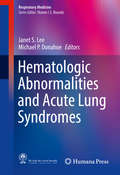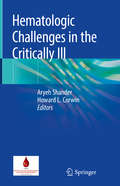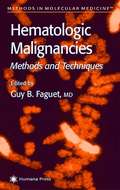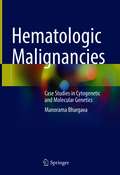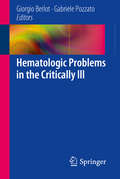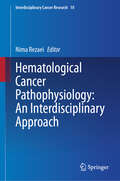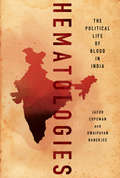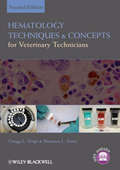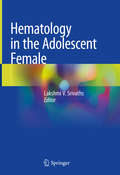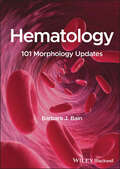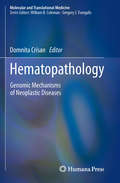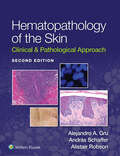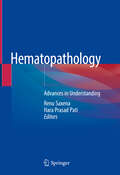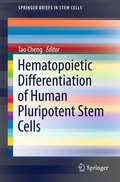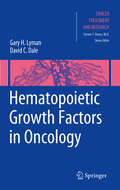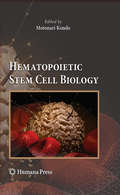- Table View
- List View
Hematologic Abnormalities and Acute Lung Syndromes
by Janet S. Lee Michael P. DonahoeThis book provides a unique frame work for examining acute lung syndromes that arise from hematologic disorders or is defined by a hematologic abnormality as a key feature. Acute lung processes arising from hematologic disorders can present as life-threatening conditions, and as such, the pulmonary physician or critical care physician are often directly involved in care or called upon to provide expertise. Chapters are organized into three sections, each with an emphasis on pathogenesis and current understanding of mechanisms. The text begins with the central theme of the lungs as the direct interface between the external environment and blood, description of individual components of the hematopoietic system, their function and relevance to the lungs. The second section outlines both benign and malignant primary hematologic disorders that can lead to acute pulmonary manifestations. The final section focuses on acute lung syndromes stemming from complications of transfusion and treatment. Chapters are presented in an easy-to-access format, providing information on diagnosis, management, and outcomes. This is a valuable resource for pulmonary fellows in training, pulmonologists, critical care physicians, and physicians involved in caring for patients in the ICU.
Hematologic Cancers: From Molecular Pathobiology to Targeted Therapeutics
by Eduardo Sotomayor Jianguo TaoIn the last decade, there has been a remarkable explosion of knowledge in hematologic cancer from basic molecular biology and pathology to clinical therapy. This has led to many new advance and insights in the understanding of pathobiology of malignant hematology. New knowledge of disease molecular pathology, cytogenetic, epigenetic and genomic alterations have provided new strategies to attack and eradicate tumor cells at molecular level and significantly impacted our current therapeutics for hematological malignancies. The recent and ongoing rapid expansion of knowledge in this area has become extensive, dynamic and diffuse over the literature and research publications. This has led to the need to capture and compile the new and current information about hematologic cancer with special emphasis on translation from molecular pathobiology to targeted therapeutics. In this book experts from around the world share their thoughts and knowledge about the pathobiology of hematologic cancer, as well as their view on current treatment approaches and future development in these malignant hematologic diseases. This book is well suited for hematology residents, fellows and hematology-oncology physicians, hematopathologist as well as basic research scientist in the area of hematologic malignancies.
Hematologic Challenges in the Critically Ill
by Aryeh Shander Howard L. CorwinThis volume provides a comprehensive overview of hematologic issues that clinicians regularly encounter in the critical care environment. The text features hematologic scenarios that affect the adult ICU patient, outlines pathogenesis and challenges associated with the hematologic disorder, and offers treatment modalities. Hematologic issues covered include anemia, hemostatic abnormalities, and risks of transfusion. The book also details challenges in specific ICU populations, such as patients afflicted with liver disease, brain injury, sepsis, cardiovascular disease, malignancy, and trauma. Written by experts in the field, Hematologic Challenges in the Critically Ill is a valuable resource for clinicians in the critical care environment who treat critically ill patients afflicted with hematologic complications.
Hematologic Malignancies
by Guy B. FaguetIn Hematologic Malignancies: Methods and Techniques, a panel of acknowledged experts review many of the key molecular methods used for the diagnosis and subsequent management of hematologic malignancies. These clinically relevant techniques range from routine test procedures to highly sophisticated methods currently offered only by specialized reference laboratories, and fall into five major groups: cytogenetics, polymerase chain reaction, flow cytometry, cytochemistry and immunochemistry, and apoptosis and cytokine receptors. Serving both clinical and experimental needs, Hematologic Malignancies: Methods and Techniques provides an array of powerful tools that will guide clinicians- especially hematologists, oncologists, and pathologists-to better diagnose and manage their patients with hematologic malignancies, and enable researchers to assess the anticancer effect of agents that impact cancer cells at the molecular level.
Hematologic Malignancies: Case Studies in Cytogenetic and Molecular Genetics
by Manorama BhargavaThis book is a compendium of case studies in hematologic malignancies such as acute leukemias, myelodysplastic and myeloproliferative neoplasms, chronic leukemias and multiple myeloma covering cytogenetics (karyotyping Fluorescence in sitn hybridization (FISH)) and molecular studies in detail. The first few chapters describe the methodology employed for karyotyping, FISH and Real Time PCR technology conducive to establishment of these labs if required. Each case study is described in detail by including the clinical history of the patient, findings of peripheral blood, bone marrow aspirate and bone biopsy morphological details. This is then followed by flowcytometric immunophenotyping, cytogenetic and molecular observations leading collectively to a final diagnosis, A discussion follows based on the relevance of this data in informing the prognosis, treatment response and survival in these patients. Additionally, this data serves as a key determinant for clinical decision making involving evidence based rational management of patients including targeted therapy. For better understanding, each case study is accompanied by black and white or colour images as appropriate. This book is a source of learning and a valuable read for clinical hematologists, hematopathologists, medical oncologists, residents, interns, DM Hematology students and DNB Hematology students as well.
Hematologic Problems in the Critically Ill
by Giorgio Berlot Gabriele PozzatoThis book covers a wide array of hematologic problems commonly encountered in the daily practice of critical care and emergency medicine. Unfortunately, the symptoms and signs associated with underlying hematologic disorders are frequently rather unspecific and confounding; furthermore, the clinical course of patients admitted to intensive care units with such disorders can be fulminant, warranting prompt diagnosis. This book recognizes the importance of accurate and speedy interpretation of symptoms in that the text is symptom oriented rather than disease oriented. Put another way, the reader confronted with a particular clinical problem or symptom will be guided step by step to the possible underlying disorder(s). The scenarios considered include critical illness in patients with anemia, leukopenia, leukocytosis, abnormal platelet count, and severe transfusion reactions. For each circumstance, factors relevant to symptom interpretation are fully discussed. In addition, helpful diagnostic algorithms are presented in the form of flow charts that will assist in decision making regarding the need for further investigations. The closing chapter is devoted to the drug-induced hematologic disorders. Although the book is intended mainly for intensivists, other specialists will find much information of value for their daily practice.
Hematological Cancer Diagnosis and Treatment: An Interdisciplinary Approach (Interdisciplinary Cancer Research #11)
by Nima RezaeiThe “Hematological Cancer Diagnosis and Treatment: An Interdisciplinary Approach” is the eleventh volume of the “Interdisciplinary Cancer Research” series, publishes a comprehensive volume on the diagnosis and treatment of hematological cancers. The eleventh volume of the book, entitled “Hematological Cancer Diagnosis and Treatment: An Interdisciplinary Approach” starts with a general title on stem cell therapy and hematological cancers. Diagnosis and therapy for acute myeloid leukemia, chronic lymphocytic leukemia, multiple myeloma, and lymphoma are explained in this volume. This is the main concept of Cancer Immunology Project (CIP), which is a part of Universal Scientific Education and Research Network (USERN). This interdisciplinary book will be of special value to hematologists and oncologists who wish to extend their knowledge on hematological cancer.
Hematological Cancer Pathophysiology: An Interdisciplinary Approach (Interdisciplinary Cancer Research #10)
by Nima RezaeiHematological cancers or blood cancers are a heterogeneous group of malignant neoplasms, including leukemia, lymphoma, and myeloma, primarily affect the blood and bone marrow. The “Hematological Cancer Pathophysiology: An Interdisciplinary Approach” is the tenth volume of the “Interdisciplinary Cancer Research” series, publishes a comprehensive volume on the pathophysiology of hematological cancers. This volume has an interdisciplinary approach in hematological cancers, including myeloproliferative neoplasms, T-cell lymphoma, Hodgkin's lymphoma, non-Hodgkin's lymphoma, and intraocular lymphoma. Waldenstrom macroglobulinemia and IgG4-related diseases are also discussed in the last chapters. This interdisciplinary series is of special value to researchers working on hematology and oncology. This is the main concept of Cancer Immunology Project (CIP), which is a part of Universal Scientific Education and Research Network (USERN). This interdisciplinary book will be of special value to hematologists and oncologists who wish to extend their knowledge on hematological cancers.
Hematological Complications in Obstetrics, Pregnancy, and Gynecology
by Rodger L. Bick Eugene Frenkel William Baker Ravindra SarodeThere are many hematological complications associated with obstetrics, pregnancy and gynecology, and unfortunately, they often lead to significant morbidity or mortality for both mother and child. As the first comprehensive reference on all aspects of hematological complications of obstetrics, pregnancy and gynecology this book will be a valuable resource to hematologists, obstetricians, gynecologists, reproductive medicine specialists, internists, anesthesiologists and others. The chapters are written by acknowledged experts in the field, and for each condition covered the etiology, pathophysiology, clinical and laboratory diagnosis and management are discussed where appropriate.
Hematological Malignancies
by Magdalena CzaderIncreased knowledge on the pathogenesis of hematologic diseases has been translated into diagnostic and prognostic applications. Hematopathology and laboratory hematology were among the first disciplines to embrace molecular diagnostics. Hematological Malignancies:Methods and Protocols, explores molecular-based assays frequently used in the routine diagnostic hematopathology and laboratory hematology. Many of these protocols were initially developed as research applications and were further refined as they transitioned to the diagnostic laboratory. Written in the highly successful Methods in Molecular BiologyTM series format, chapters include introductions to their respective topics, lists of the necessary materials and reagents, step-by-step, readily reproducible laboratory protocols, and key tips on troubleshooting and avoiding known pitfalls. Authoritative and practical, Hematological Malignancies: Methods and Protocols aids scientist in the continuing study of tests essential for contemporary laboratory diagnostics of hematological neoplasms.
Hematologie
by E.A. Tanasale-Huisman J.C. Kluin-NelemansHet boek Zorg rondom hematologie maakt deel uit an de Zorg rondom-reeks. Dit is een boekenreeks met boeken die vooral worden voorgeschreven in de opleiding tot verpleegkundig specialist. De reeks bestaat uit 8 delen, waarvan het deel Oncologie (wordt op dit moment ook herzien) en hematologie in de opleiding tot oncologieverpleegkundige worden voorgeschreven.
Hematologies: The Political Life of Blood in India
by Jacob Copeman Dwaipayan BanerjeeIn this ground-breaking account of the political economy and cultural meaning of blood in contemporary India, Jacob Copeman and Dwaipayan Banerjee examine how the giving and receiving of blood has shaped social and political life. Hematologies traces how the substance congeals political ideologies, biomedical rationalities, and activist practices.Using examples from anti-colonial appeals to blood sacrifice as a political philosophy to contemporary portraits of political leaders drawn with blood, from the use of the substance by Bhopali children as a material of activism to biomedical anxieties and aporias about the excess and lack of donation, Hematologies broaches how political life in India has been shaped through the use of blood and through contestations about blood. As such, the authors offer new entryways into thinking about politics and economy through a "bloodscape of difference": different sovereignties; different proportionalities; and different temporalities. These entryways allow the authors to explore the relation between blood's utopic flows and political clottings as it moves through time and space, conjuring new kinds of social collectivities while reanimating older forms, and always in a reflexive relation to norms that guide its proper flow.
Hematology Rapid Review: Flash Cards
by Utkarsh Acharya Tejaswini M DhawaleFace the hematology board certification with confidence! Hematology Rapid Review, created and edited by Drs. Utkarsh H. Acharya and Tejaswini Dhawale, is a conveniently portable and effective review tool that helps learners at all levels prepare for this challenging exam. Sturdy, full-colored, flash cards provide an efficient and focused review anytime, anywhere.
Hematology Techniques and Concepts for Veterinary Technicians
by Gregg L. Voigt Shannon L. SwistNow in full color, Hematology Techniques and Concepts for Veterinary Technicians, Second Edition is a thorough update to this introduction to the fundamental concepts of collecting, handling, and preparing hematology samples. Covering the basics of blood composition, cell morphology, and sample collection, handling, and preparation, the book is designed specifically for veterinary technicians and students to gain a full understanding of why each test is performed and ensure accurate test results. In addition to addressing advances in technology, equipment, and test techniques throughout, a new chapter covers automated testing, and a companion website provides review questions and images from the book for download at www.wiley.com/go/voigt. Key concepts have also been added to each chapter to better promote learning, and terms are now defined throughout the text, with the definitions collected into a glossary. User-friendly and well-illustrated with charts, reference values, algorithms and photomicrographs, Hematology Techniques and Concepts for Veterinary Technicians, Second Edition is a key reference for veterinary technicians and veterinary technology students.
Hematology Techniques and Concepts for Veterinary Technicians (2nd edition)
by Gregg L. Voigt Shannon L. SwistThe major reason for the preparation of this second edition is to introduce the veterinary technology student to new technology, equipment, and test techniques that are becoming more available in the field of veterinary hematology. The intent of the new edition remains the same as in the previous edition. It is an introductory overview of veterinary hematology and a guide for the student to learn the fundamental concepts of collecting, handling, preparing, and testing blood and other samples in the hematology laboratory. It is not intended as a diagnostic aid, differential disease discussion, or complete atlas of blood cells.
Hematology in the Adolescent Female
by Lakshmi V. SrivathsAdolescent females experience a variety of blood disorders that are often unique to this patient population. As they go through puberty, they are uniquely poised to encounter various bleeding and thrombotic disorders once they attain menarche, start to have menstrual bleeding, and require hormonal therapy. This may in turn lead to other medical conditions, such as anemia and iron deficiency. Pregnancy encountered by some adolescents can pose hematologic challenges specifically in regards to bleeding and thrombotic disorders. In addition, adolescent females are at risk to develop immune mediated hematologic disorders, such as immune thrombocytopenia, auto-immune hemolytic anemia, and thrombotic thrombocytopenic purpura, as well as vitamin deficiencies due to pernicious anemia. Sickle cell disease, thalassemia and bone marrow failure disorders in the adolescent female poses unique challenges that need to be addressed with special care and attention. Knowledge about these various blood disorders in adolescent females is crucial for the treating physician in order to accurately diagnose and optimally manage these teenagers. Otherwise, it can affect their overall health, causing hematologic and gynecologic issues, poor quality of life, neurocognitive impairments, and poor psycho-social development, all of which can lead to various complications immediately and into adulthood.This book provides a comprehensive, state-of-the art overview of blood disorders in female adolescents. The text presents new data about bleeding disorders that affect the female adolescent, including bleeding disorders, thromboembolism, thrombophilia, anemia, sickle cell disease and thalassemia, disorders od hemostasis and thrombosis in pregnancy, immune hematology and bone marrow failure disorders; reviews our current understanding of these disorders; outlines recent research findings; and spotlights multi-disciplinary approaches, evaluation and treatment modalities to combat these blood disorders.Written by experts in the field, Hematology in the Adolescent Female is a valuable resource for clinicians and practitioners who treat and manage female adolescents with blood disorders.
Hematology: 101 Morphology Updates
by Barbara J. BainHematology Timely morphology resource based on ongoing series of morphology updates published in the American Journal of Hematology since 2008 This is the first book of its kind, written by renowned author Professor Barbara J. Bain, featuring a collection of instructive cases with interesting morphological features initially published in the American Journal of Hematology. This new book aims to bring these interesting and instructive cases to a wider readership. This book features updated cases and a “Test Yourself” section to aid in reader comprehension and information retention. Cases covered in Hematology: 101 Morphology Updates include: The significance of irregularly contracted cells and hemighosts in sickle cell disease, and striking dyserythropoiesis in sickle cell anemia following an aplastic crisis Prominent Howell-Jolly bodies when megaloblastic anemia develops in a hyposplenic patient, and unusual aspects of G6PD deficiency The cause of sudden anemia revealed by the blood film, chorea-acanthocytosis and dysplastic neutrophils in an HIV-positive woman Neutrophil dysplasia induced by granulocyte colony-stimulating factor, and diagnosis of pyrimidine 5'-nucleotidase deficiency suspected from a blood film Hematology: 101 Morphology Updates is a key resource for consultant hematologists and clinical scientists, trainee hematologists and biomedical scientists. The audience may use this book to solve difficult diagnostic problems or as a source of teaching cases: for both personal learning, including exam revision or solving difficult cases, and as a teaching resource.
Hematopathology
by Domnita CrisanHematopathology: Genomic Mechanisms of Neoplastic Diseases will keep physicians abreast of the rapid and complex changes in genomic medicine, as exemplified by the molecular pathology of hematologic malignancies. This timely volume will update physicians on the complexities of genomic lesions, as well as offer an integrated framework encompassing molecular diagnosis, the new WHO classification of hematologic neoplasms with focus on molecular pathology, prognostic value of molecular tests, and molecular monitoring of response to gene-targeted therapy. As such, it will be of great value to hematologists, oncologists, pathologists, internal medicine and pediatric specialists, as well as bioscientific staff and laboratorians in private hospitals and academic institutions.
Hematopathology and Coagulation: Self-Assessment and Board Review
by Wahed Amer Jaso Jesse Manuel Tholpady AshokA clear understanding of key areas in hematopathology, hematology and coagulation is essential for all trainees preparing to take their American Board of Pathology exams. This text offers a series of increasingly challenging multiple-choice questions and answers designed to help strengthen your knowledge. Question papers cover all areas of study, from red blood cell count and coagulation disorders to hematopoietic neoplasms. Each answer is accompanied by explanations and overviews of associated topics, enabling you to learn from mistakes and to revise effectively.
Hematopathology of the Skin: Clinical & Pathological Approach
by Alejandro A. Gru Andras Schaffer Alistair RobsonThe most comprehensive reference book on diagnosing cutaneous hematologic disorders available, Hematopathology of the Skin: Clinical and Pathological Approach, 2nd Edition, provides interdisciplinary guidance from more than 40 global experts in the fields of dermatopathology, dermatology, hematopathology, and hemato/oncology. Edited by Dr. Alejandro A. Gru, Dr. András Schaffer, and Dr. Alistair Robson, this concise yet comprehensive reference features a logical, consistent format heavily illustrated with high-quality clinical and pathological images throughout. Unparalleled in scope, it is a well-written, easy-to-follow resource for clinicians who care for patients with cutaneous hematologic neoplasms.
Hematopathology: Advances in Understanding
by Renu Saxena Hara Prasad PatiThis book covers recent advances in the understanding and management of essential hematological pathologies. In addition to updates on Hodgkin’s lymphoma, acute myeloid leukemia and other disorders, it provides essential information on transplant pathology, and the molecular and genetic aspects of hematological disorders. Offering a practical approach to lymphoma diagnosis, the book will help hematologists and pathologists alike make accurate diagnoses in keeping with the latest classifications and methodologies. A wealth of photographs and algorithms help readers understand the laboratory approach to the diagnosis of hematological disorders, reflecting the latest advances in the field. The book offers a valuable resource for residents of MD pathology, DM hematopathology and clinical hematology, as well as practitioners of hematology.
Hematopoietic Cell Transplantation in Children with Cancer
by Gregory H. Reaman Franklin O. Smith Judy M. RacadioThis book is a comprehensive and up-to-date compendium on all aspects of blood and marrow transplantation in children. After an introductory chapter describing the history of pediatric blood and marrow transplantation, subsequent chapters discuss pediatric-specific aspects of transplantation, including stem cell sources suitable for transplantation, preparative regimens, graft-versus-host disease, complications related to transplantation, and late effects. The role of blood and marrow transplantation in various specific pediatric diseases is then examined, and the closing chapter considers future directions. The authors are all internationally recognized experts and offer a largely evidence-based consensus on etiology, biology, and treatment. This handbook has far-reaching applicability to the clinical diagnosis and management of pediatric diseases that are treatable with blood and marrow transplantation and will prove invaluable to specialists, generalists, and trainees alike.
Hematopoietic Differentiation of Human Pluripotent Stem Cells
by Tao ChengThis book features the most cutting-edge work from the world's leading laboratories in this field and provides practical methods for differentiating pluripotent stem cells into hematopoietic lineages in the blood system. Pluripotent stem cells have attracted major interest from a fast-growing and multidisciplinary community of researchers who are developing new techniques for the derivation and differentiation of these cells into specific cell lineages. These direct differentiation methods hold great promise for the translational applications of these cells. This book is an essential reference work for researchers at all levels in the fields of hematology and stem cell biology, as well as clinical practitioners in regenerative medicine.
Hematopoietic Growth Factors in Oncology
by Gary Lyman David C. DaleProgress in the treatment of cancer over the past two decades has been rapid with many new and novel therapeutic modalities arriving at an unprecedented pace. Overall cancer mortality rates have actually begun to fall in parallel with progress in the diagnosis and treatment of malignant disease. Despite our advances in the understanding of the biology and molecular genetics of cancer, as well as the availability of an increasing array of effective therapies, cancer treatment today and for the foreseeable future will include the traditional modalities of surgery, radiation therapy and chemotherapy. Myelosuppressive agents with their potential hematopoietic toxicities remain the mainstay of systemic treatment for both metastatic and early stage cancer. The complications of cancer chemotherapy have serious impact on a patient's well being and overall quality of life. Fortunately, advances in cancer treatment have been accompanied by equally impressive progress in the availability of a wide array of supportive care modalities which have greatly enhanced the ability of oncologists to minimize the impact of cancer and its treatment on patient quality of life as well improve delivery of potentially curative cancer treatment. Despite the increasing complexity of modern cancer treatment, it is the obligation of the oncologist as well as the entire cancer care team to be certain that cancer patients receive the optimal supportive care available for their disease and its treatment. Among the most serious and potentially life threatening toxicities of cancer treatment are the hematologic toxicities accompanying myelosuppression including anemia and associated asthenia and fatigue, neutropenia and fever associated with infection in the immunocompromised patient and thrombocytopenia and accompanying risk of bleeding. Special supportive care needs arise in the very elderly care patient that may tax the ability of even the most skilled clinician. Despite the considerable progress that has been made with more effective and safer treatment strategies, myelosuppressive chemotherapy will remain the mainstay of systemic treatment for cancer for the foreseeable future. While considerable progress has occurred, better methods and broader application of supportive care measures are needed to reduce the symptomatic effects of cancer and the associated toxicities associated with cancer treatment. No area of cancer supportive care better illustrates the progress that has resulted from advances in our understanding of cellular and molecular biology, genetic engineering and the development of more effective yet often more toxic cancer treatments than that of the hematopoietic growth factors. This volume will review and integrate the major advances in our understanding of the underlying molecular biology and pharmacology of these agents along with the results of well designed and executed randomized controlled trials of the erythroid stimulating agents, the myeloid growth factors and the new thrombopoietic agents each addressing a major threat associated with bone marrow suppression accompanying cancer treatment. The current clinical utilization of these agents is based on numerous randomized controlled trials and meta-analyses along with evidence-based clinical practice guidelines developed by professional societies guiding their appropriate and cost-effective use in clinical care.
Hematopoietic Stem Cell Biology
by Motonari KondoThis book is written by experts in the field of hematopoietic stem cell biology and lymphocyte development in order to overview recent advances in the field. Prospective isolation of various progenitors and stem cells enables us to understand self-renewal mechanisms of stem cells as well as regulation of hematopoiesis. Furthermore, the importance of extrinsic factors has been emphasized recently. This volume concisely describes our current understanding of normal hemato/lymphopoiesis as well as abnormal hematopoiesis, which may lead to leukemia.
